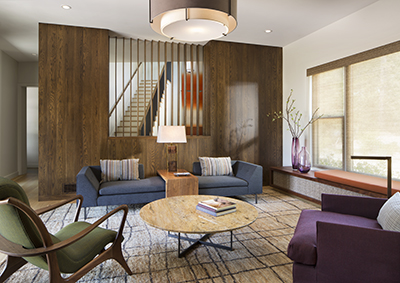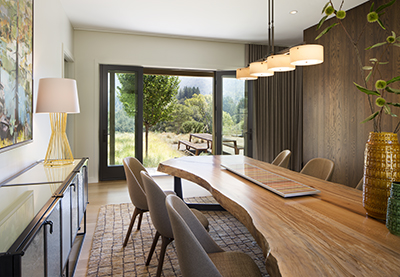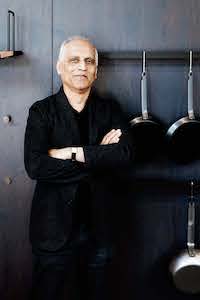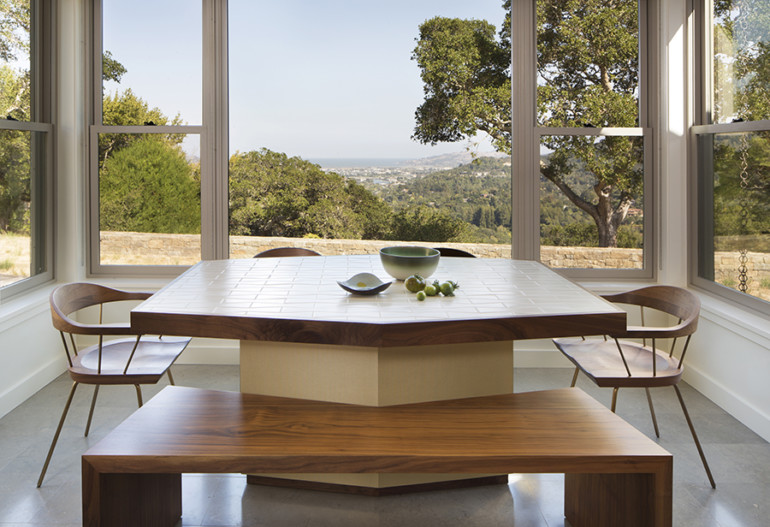 FOR ROBYN DABORA and her husband, David, who is a financier and money manager, moving from San Anselmo to a more rural part of Marin made perfect sense because they love the outdoors.
FOR ROBYN DABORA and her husband, David, who is a financier and money manager, moving from San Anselmo to a more rural part of Marin made perfect sense because they love the outdoors.
In their early 50s and originally from small college towns (she is from Kentucky, he from Connecticut), the sports-minded couple also wanted to share a semblance of their childhood with their high-school-age children, Rachel and Josh.
They found a spot to build on, just outside Kentfield, in an ideal neighborhood where coastal oak and redwood trees thrive, grasses turn golden in the summer, and coyotes and foxes roam free.
Their plans never included “an ultra-modern structure,” Robyn says. With the help of architect Kevin Killen of the San Francisco firm EHDD, they envisioned a relatively simple, eco-friendly wood frame ranch house with gabled and shed roofs on their three-acre property.
Unlike their former colonial-style home, the new 4,600-square-foot cedar wood-clad house hearkens back to the updated gabled barn forms that the late architect Joe Esherick, who co-founded EHDD, introduced at Sea Ranch during the 1960s.
In back, the U-shaped house wraps around a sheltered courtyard centered on a south-facing view of Mount Tamalpais. Inside, a foyer, a parlor and dining room are laid out in a row in the middle wing, separated only by wood-clad partition walls. An eat-in kitchen in the east wing has views of San Francisco Bay, and next to it are an office and a family room. In the two-story west wing, the master suite and a guest room are downstairs, while children’s rooms are up on the top floor.
Shortly after Killen’s understated shell was first conceived, the Daboras stumbled upon San Francisco interior designer Steve Justrich’s website and rapidly hired him because they liked what they saw, including his design for a project in Big Sur. They consulted with Justrich Design on interior finishes and chose locally produced materials, especially in the bathrooms and the kitchen, where the backsplashes have Heath tiles. Justrich also suggested flooring material, custom carpet sizes and furniture layouts, but surprisingly, although their home was completely built about a year ago, the Daboras simply could not decide on new furniture.
Killen’s architecture had provided them with a sort of clean slate, with mostly white walls inside and freestanding partitions of oak wood between public rooms that was quite different from what they were used to.
“Although our old furniture did not quite fit his 10-foot-high rooms with large windows, we hung on to it while we tried to understand what we really wanted,” Robyn says.
Then, one day, keen to find a breakfast table that would fit comfortably into a small bay window in the kitchen, they yielded to Justrich’s proposals for a custom piece. That’s what it took to break the logjam of indecision.
 “David and I can appreciate nice things but we simply could not visualize custom objects. Steve, on the other hand, could sketch things in color within minutes,” Robyn says.
“David and I can appreciate nice things but we simply could not visualize custom objects. Steve, on the other hand, could sketch things in color within minutes,” Robyn says.
His unique six-sided kitchen table, featuring a top covered with bow-tieshaped Heath ceramic tiles, came with a walnut bench that is shaped by San Francisco woodworker Jim Sellars to fit against the angular, corrugated metal-clad golden table base. Curved Bassam Fellows walnut and brass spindle dining chairs — like modern Windsor chairs — followed as the ideal foil.
“It was a test run,” Justrich says. “They told me they were ready for a minimal, modern approach, and this told me how far they would veer from a traditional look.”
More of his designs followed, and gradually they consigned the old furniture to vintage stores.
“We made everything lower, because the windows started low, and wherever possible the furniture, such as a long bench in the living room, is integrated with the architecture,” Justrich says.
He also took cues from EHDD’s naturalistic palette and added colors to doors and windows, all derived from the landscape. The painted front door’s Aztec orange color, shades of gold like the grasses outside, and the gray of weathered wood appear again in upholstery fabrics and floor-to-ceiling drapes that hang from a single curtain rail along the contiguous south wall of the central wing.
In the narrow double-height foyer where stacked windows on the west wall made the installation of other kinds of art impossible, he commissioned an orange ombre wall hanging of diaphanous wool by Rosemary Hallgarten. It hangs above a high-back De La Espada bench and cleverly covers both windows without blocking the light.
Custom and store-bought pieces complement each other in other rooms. In the master bedroom a Platner lounge chair from Knoll is paired with a custom daybed with a spindle back, and in the family room an angular sectional sofa is paired with an organically shaped coffee table Justrich designed. The cast-concrete tabletop impressed with a burlap texture was made by Oakland’s Concreteworks.
“It was cool. Obviously Steve wasn’t against buying ready-made things, but with his eye for space, he also worked with manufacturers to modify furniture like our bed to fit our room better,” Robyn says.
The owners enjoyed watching these designs taking shape. Granite for the kitchen counters came from Fox Marble in San Francisco, “and it was fascinating to pick from the large sheets of stone in their warehouse,” she recalls.
In the dining room, Justrich designed a table with raw wood from Evan Shively in West Marin; Lawrence Gandsley in Emeryville made its steel base. The steel-and-glass sideboard was made to measure by Ted Boerner of San Francisco.
But the breakfast table Justrich designed is still the star. “I sip coffee at this table every morning, and in the evening David comes up to it with his iPad,” Robyn says. “We have family dinners there. Even when we are in a rush, we migrate from the kitchen island to that table. It’s our reward.”
View the gallery below for more photos.

Zahid Sardar brings an extensive range of design interests and keen knowledge of Bay Area design culture to SPACES magazine. He is a San Francisco editor, curator and author specializing in global architecture, interiors, landscape and industrial design. His work has appeared in numerous design publications as well as the San Francisco Chronicle for which he served as an influential design editor for 22 years. Sardar serves on the San Francisco Decorator Showcase design advisory board.


